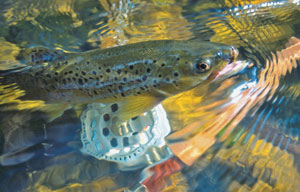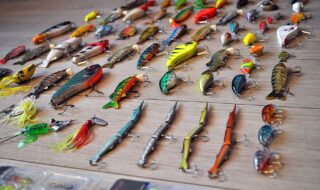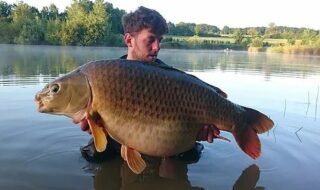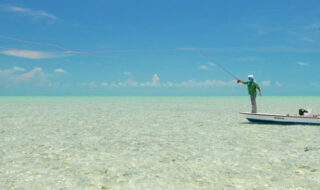All about our beautiful, beloved brown trout….
Fish Biology
This might not mean a whole lot to you but it should if you are an admirer of the wild brown trout, if you are a hunter of the wild fish that have been with us since the retreat of the last ice age. Even if you’re only going to be fishing for wild browns around the UK, look carefully at all the fish you catch. Better still, photograph them and analyse them in the evening on your computer, at your leisure. You will begin to notice huge variations in colouration and spotting patterns, even from river catchment areas a few miles apart. You’ve immediately stumbled onto the heart of a question that has stumped fishery scientists for one and a half centuries. Is our wild brown trout one species with many forms? Or is there, in fact, more than one species within the scope of the brown trout family? Are some forms of trout just so different from the norm that they qualify to be a subspecies in their own right?
Stocking
Are your wild browns, no matter how remote the stream you’re catching them in, actually wild at all? Man is a meddler. He’s always interfered in the affairs of nature. When he’s an angler, a water is never quite good enough for him. If the trout are on the small side, no matter how perfectly formed, then he’s got to stock bigger, farm-bred fish that aren’t wild at all. The odds are that these introduced fish will simply clear off because they don’t know to access food sources like the wild fish do. And if they don’t clear off then, worse, they stay and they spawn and they adulterate the gene pool of the wild fish that have been present for 12,000 years.
 |
| Hampshire’s chalkstreams largely contain stocked brown trout, contrary to popular belief. |
The Challenge
Wild fish that have been in their streams and rivers for aeons have grown to suit their environment to perfection. They are the ideal fish, grown to perfection through countless generations. Their immaculate colouration, spotting and nobility screams at you. Look again at those photographs. It’s like some ecstatic god has gone crazy with his paint box. There’s yet more. Wild browns in this country present the ultimate, absolute challenge for the fly angler. The millennia have bred in them a wariness that stocked fish can never possess. A wild brown owes its very existence to its wits and always has done. Because a mistake means death, they don’t make many of them.
My first experiences with these fish taught me these things many years ago. During the summer holidays of 1963, day after day I took the train out of Greater Manchester southeastwards to the grand, open, moorland spaces around the village of Hayfield. I’d trek for ever through the heat towards the tiny, crystal, gushing rivulet and I’d use the upstream worm for the miniature wild browns that swarmed there. To get anything out of that stream demanded the most sophisticated watercraft from a lad not yet at grammar school. Complete accuracy in the cast was vital, which was not easy with a poker-stiff little rod, line that lay as bristly as barbed wire and a reel ground like a bag of spanners. The approach, too, had to be perfect – even the crunch of a size 2 could destroy the day.
I don’t know if I was poaching but I do know that after a few days of taking home tiny troutlings, half putrefied by the summer heat, my mother made it quite clear that she wanted no more of them. So, back then, I invented catch and release! Forget what the Yanks say, it all started in Manchester 40 years back. And it was putting the fish back alive that made the technique become interesting and more skilful. Bite detection and instant striking became all. Soon it became a point of pride that the fish would be lip hooked and easily set free. A hook down deep meant blood, death and a lost little life, not to mention a good few tears.
The best advice ever given me when pursuing wild stream brown trout was passed on by Hugh Falkus 20 years back. “Look, look, look,” he would boom at me prophet-like as we crept his streams. “Never make a move until you can see the fish, consider its lie, and work out a strategy. These are the pinnacle of God’s creations, cleverer than you and me – the perfect fishes.” I knew all this from my Hayfield days but he did teach me that in crystal-clear water you’d often only see the tiniest browns by the shadow they cast on the riverbed. And he also told me that the biggest wild browns get that way because they’re catholic in their diet. Grasshoppers, moths, voles and mice are what the leviathans are made of. And so it has always proved; a tiny mouse pattern tripped back across the deepest pool has always landed me the biggest fish in a thousand streams since. Halford would squeal, and the fly fishers would kick me out, but that’s how it is.
My pursuit of wild browns has been dogged by failure. The hardest browns to catch that I ever came across lived in the River Barle, a tributary of the Exe. Even though they were only a handspan in length, these fish were impossible to catch on the fly until a tinge of colour entered the river. The only way I could take a single fish was to suspend a tiny midge under the rod tip, one, two or three inches above the water’s surface. Providing that no line, not even an inch, lay on the water, a small, perfect trout might just flip out, grab the fly and be caught. Whatever ruse I tried, three fish for 6oz in an eight-hour day would be a good reward.
 |
| The turquoise waters of Slovenia are a brown trout angler’s paradise. |
I failed totally with the big wild browns of the mid Wensum millpools in my teenage years. These fish were bred high in the headwaters and dropped downriver until they hit the pools that were full of minnows and gudgeon and there they waxed fat. But greed never got the better of them. They’d always look again and again at any offering I presented over five miserably frustrating years. It was spooky – supernatural. The only fish I heard of taken during that time was on a dead bullhead legered at night. That one was 71/2lb but it was a cheat and I didn’t acknowledge it.
But the wildest of wild browns can be caught. I remember a walk to the River Kingie up in Glen Garry years back. The river was miles from the nearest track, set in thousands of acres of barren moorland, so the fish were as wild as they were at the retreat of the ice. My first cast was taken by a primrose-bellied one-pounder. On my second cast the result was exactly the same. I wandered free the day long. I saw not a soul, not a footprint, not a skerrick of evidence that anyone had ever fished here since man stopped wearing furs! I had 73 fish, all but two of which were returned. The two fish I kept were cooked by the side of a pool before the long hike home. So it can be done if you have faith and skill and a massive slice of luck.
Reading
You must read ‘The Nature of Brown Trout’ by Nick Giles (Perca Press 2005 www.percapress.com) if you’re at all serious about wild fish in wild streams. This is a great book. It takes you right to the core of what we’ve got in our islands, a treasure chest of wild fishing. It’s a masterpiece. But I should also recommend Terry Lawton’s new piece of work, ‘Fly Fishing in Rivers and Streams’, to be published by New Holland in 2007. Terry is a master of the wild fish in small streams and I was privileged to read a draft of his fascinating book some months back.
Conservation
You must join the Wild Trout Trust (www.wildtrout.org) if you’re going to do the sensible thing and get yourself out on wild streams. In this day and age, we can’t reap without sowing. Wild browns are on unspoilt streams and no longer our God-given right. And to keep our streams unspoilt, if you don’t join the Anglers’ Conservation Association (www.a-c-a.org), it’s a crime.
Venues
Places to fish for wild browns aren’t myriad but they’re plentiful. One of the most exciting contacts I can give you is the Wye and Usk Foundation. (www.wyeuskfoundation.org). Its passport scheme to some of the most wonderful wild streams along the Welsh borders is inspirational. You can lose yourself for weeks on scores of miles of wild water. The small streams of Somerset, Devon and Cornwall are magnificent. I love the Rivers Wolf and Thrushel, and the Arundell Arms (www.arundellarms.com) can give you all the information you need there. There are great possibilities in north Lancashire, Cumbria, the Yorkshire Dales and Yorkshire Moors. And in Scotland it all goes wild. Contact Lesley Crawford (www.wildtroutfisher.co.uk) for some exhilarating sport just about as far north as you can get. And if it’s Ireland you’re going to, just for a day or two forget Corrib, Mask and all the other trumpeted hotspots. Take time out to fish the tiny River Mulcair as it twinkles through the dips and dells just outside Limerick. There you’ll find wild brown trouting in its most exquisite form (www.millbankhouse.com). Abroad, there are wonderful waters and fish in Iceland; contact Arni Baldurrson (www.lax-a.is). Or perhaps you fancy the beautiful scenery of Slovenia. Information about trips to this magnificent country can be obtained from Casting for Gold (www.castingforgold.net).





